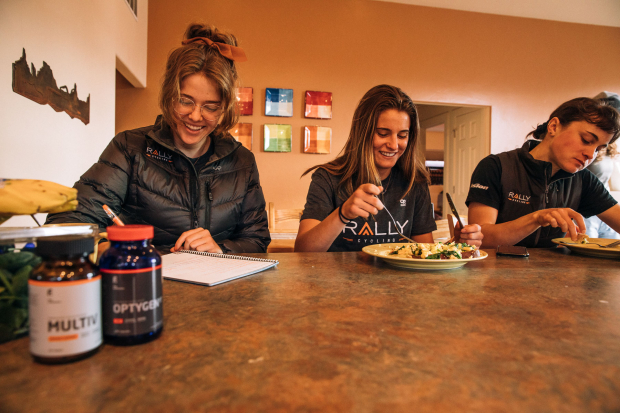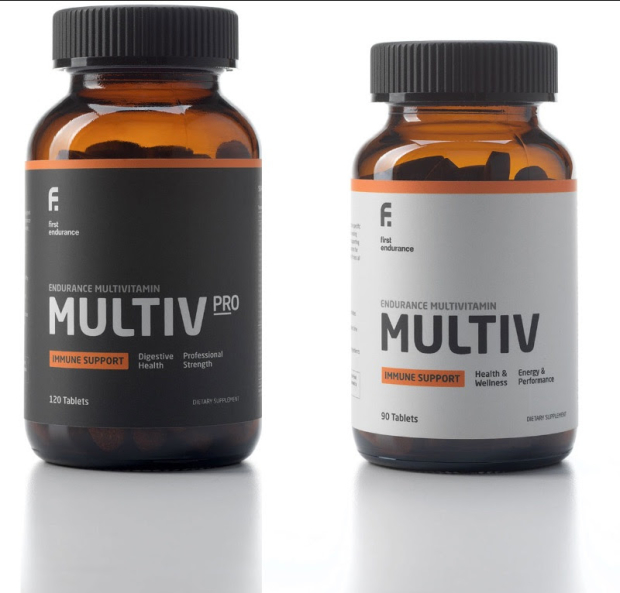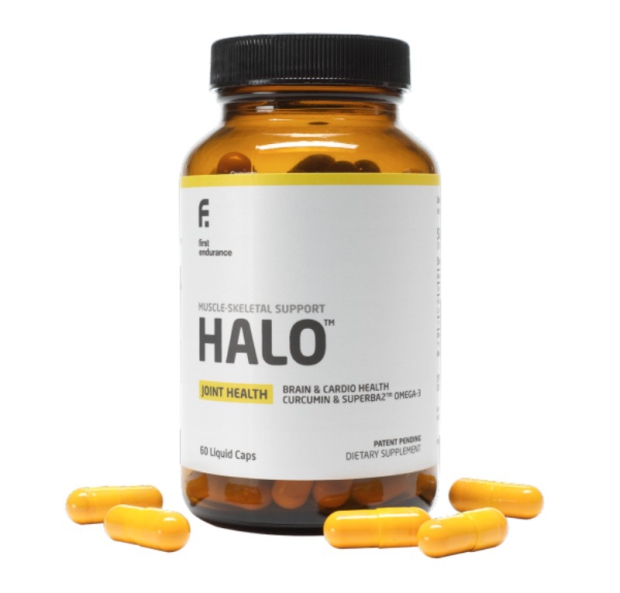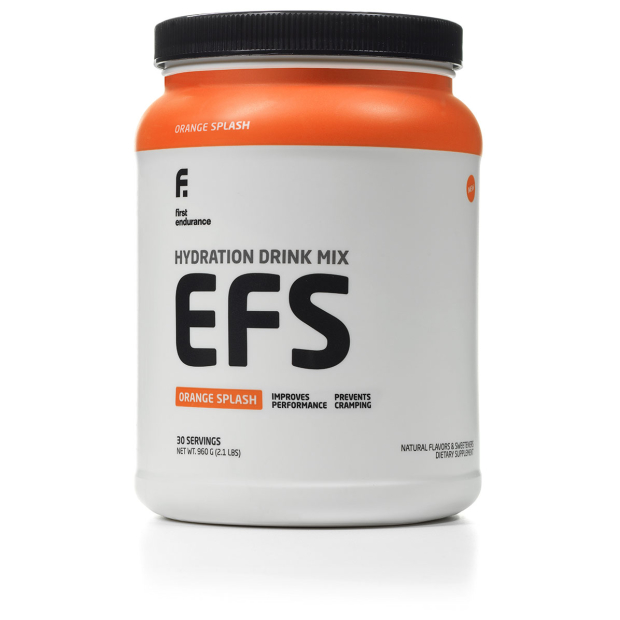First Endurance: Looking Beyond Calories

One of the most interesting parts of First Endurance's product lineup is that in addition to the core products that you'd expect from a sports nurtrition company – electrolyte and recovery drinks as well as gels, they also have several "supporting" products you might not expect. Note that I mean that as supporting physical systems, not supporting roles within the business, as Optygen is – and has been for quite some time – their #1 selling product. While I'll be the first to admit that the plural of anecdote is not data, I nevertheless think anecdotes and experience form a core part of decision making, especially for products – and people – who tend to be outside of the norm. I certainly recognize the power of the placebo effect, and I hope that I ask Dr. Luke Bucci, First Endurance's Chief Science Officer, appropriately challenging questions about the products they sell. Nevertheless, I am of coure biased by my own positive experience. In the 9 years that I was sponsored by First Endurance, I never once DNS'ed a race due to illness, and that wasn't only because I was stubborn. I just didn't get sick. There was really only one race – Ironman Melbourne in 2013 – that I started simply out of stubbornness in spite of being sick. There were stretches where – in spite of long, hard training, I would go over a year between colds. This with (at the time) three young kids. I believed then – and believe now – that First Endurance Optygen and MultiV were a key part of that. It's why I continue to take them (though at a 50% dose, given that I train about 50% – or less – as much as I did). And I had countless – non-athletic friends – who swore by Optygen as something that helped them deal with high stress jobs.
Optygen, understandably, has always been one of the most contentious products – in spite of its absolute, no-questions-asked money back return policy. I had more heated discussions on the forum about it than probably any other product. And I think Dr. Bucci does a great job of addressing a lot of the real concerns about the extraordnary claims that plague the supplement industry. I always took the stance of "ignore the numbers; it just makes you feel better. It's up to you to figure out what that's worth." HALO, the latest support product from First Endurance, is brand new and builds on the philosophy of Optygen. It's also, notably, the first time First Endurance has filed for a patent on. This product stems from a decade plus of research by Dr. Bucci. I don't know that I stress my body enough to justify it, but I'm certainly eager to try it.
In spite of my own positive experiences, these were also always the products I struggled the most to explain as a sponsored athlete. And that's really why I wanted to do this interview. Often times, interviews are about finding a way to share a story with the audience that both interviewer and interviewee know. But not here. I learned as much from this interview as I hope all of you do too. Back when I wrote for LAVA, I was scheduled to write an article about beta-glucans, the immune support nutrient found in MultiV Pro. Ultimately, I shelved the article – and wrote about why I shelved it instead – because I just didn't feel the research was, at the time (in about 2015), compelling enough or that I understood it enough to both ask the right questions or provide the right answers. Dr. Bucci and I discuss just how new the research on some of these ingredients is, and the challenge that presents when it comes to providing athletes with the best – and latest. I especially appreciated Dr. Bucci's discussion about the discrepancy between animal lab tests and human trials in his own research.
In this, our third in the series of interviews with the team at First Endurance, we once again dive deep with Dr. Luke Bucci. While this article exists as part of that series, we will once again share Dr. Bucci's bio, as provided by First Endurance – Dr. Bucci is the industry leader in sports nutrition. He is an accomplished author and lecturer, and he holds multiple patents and patent applications on clinical laboratory testing methods and nutritional supplements. He's written four texts, contributed to eleven books, over 35 peer-reviewed research journal articles, 37 abstracts, more than 100 technical journal articles, and has presented hundreds of invited lectures and discussions on a variety of topics around the world. He also served on the United States Olympic Committee as an expert advisor on nutritional supplements.
Dr. Bucci graduated Magna Cum Laude with a PhD in Biomedical Sciences (Biochemistry and Cell Biology), from the University of Texas Health Science Center at Houston, Graduate School of Biomedical Sciences in 1983, followed by a double post-doctoral appointment at the world's largest cancer research center.

Slowtwitch: MultiV – this is a great product to start this discussion with, because there's real science here, but this is also an area of the industry where bad science and pseudoscience prevail. These products are a lot of what make First Endurance different from its competitors, but they also have the potential to be polarizing and to undercut the more established and mainstream science around endurance nutrition. MultiV is especially interesting, because vitamins are fairly mainstream. This is a product without extraordinary claims, and yet it's designed to be "different." Talk about the challenges in positioning a product that isn't meant to compete with Centrum but also isn't meant to really fall into the "supplement" category. And how you approach this category – that isn't really about nutrition or endurance in the normal way – as something that has always been core to your business.
Dr. Bucci: You mention Centrum, which is probably suitable for a large portion of the general population's lifestyle-and that's great. Endurance athletes don't fall into this category though.
Endurance training for dedicated athletes isn't just an activity or an errand; instead, it's an extremely demanding lifestyle. I realize that's cliche, but by "lifestyle," I mean that the fanatical, dedicated athletes aren't just putting in a workout and then going about their day, and the athlete's body doesn't just need support while training. These guys put themselves through the ringer, day in and day out. Their bodies are always working, whether during training or to rebuild and recover during downtime and sleep. Because of this, they have unique, significantly different daily dietary needs that must be addressed so they can stay healthy, be able to fully recover day after day, and avoid illness or chronic deficiencies that can derail training and wipe out an entire season.
MultiV is a high-potency formula that's engineered to protect endurance athletes from the unique stresses and demands of everyday training and racing. In addition to having the highest-quality, most bio-available vitamins and chelated minerals available, it also delivers nutrients that target endurance-specific micronutrient gaps and also offers performance benefits you won't find in regular multis. Ingredients that aren't found in "grocery store" multivitamins. Things like Ferrochel® iron for improved oxygen carrying capacity, zinc for enhanced recovery and green tea for improved endurance capacity and fat utilization.
MultiV is designed to be your foundation. It complements other First Endurance products, such as EFS and Optygen, as part of a truly comprehensive system of athletic nutrition supplementation, one that goes beyond training and recovery.
For vitamins and minerals, there are "sweet spots" of dose with a wide range of equivalent benefits. The dose-response is not a straight line going up, but an inverted U shape. Typical multivitamins are built to address deficiencies by following Daily Value recommendations; however, endurance athletes need more than just the Daily Value to stay healthy and avoid overtraining. In other words, we forgot the % Daily Value (% DV), focusing instead on what clinical research revealed about vitamins, minerals, and exercise. So in terms of product positioning, the focus on a dedicated endurance athlete's needs is what sets MultiV apart from regular multis.
For example, some of MultiV's letter vitamin levels (A, Bs, C, D, E, K) have been increased to take advantage of benefits shown by human clinicals trials on exercise performance. They are enough to satisfy any and all demands, teasing out benefits not realized with Daily Value levels, but the doses are not excessive to the point of toxicity. Well, they're not excessive at all – they're exactly the ideal amount for intense, long-term endurance training.
Engineering our own MVM also gave us control over when athletes ingest high doses of antioxidants. You should take them for foundational health, but too much antioxidant activity is known to slow recovery and block adaptation to training, ultimately impeding performance. By including antioxidants in MultiV, we can leave them out of things like EFS and Liquid Shot, ensuring you get them when the time is right – with a meal, but not during exercise.
Minerals are the biggest problem with MVMs. MultiV pays particular attention to unique mineral requirements of serious endurance training for both men and women. For example, MultiV's iron source, Ferrochel® (chelated ferrous bis-glycinate), is the best, most bioavailable form available, and it is delivered at a relatively high dose that is successful at promoting red blood cell formation in human studies of athletes without any risk of toxicity. Trace minerals are also over the DV simply because endurance athletes need more, and mineral combos (like MultiV) are so much better than taking high levels of any single mineral (like iron, or magnesium, or zinc). Taking them together in appropriate amounts balances them all (like a healthy diet that nobody eats), without having them interfere with each other.
But there is more to MultiV than just the essential vitamins & minerals – we included special performance enhancing ingredients that you won't find in other multivitamins. Things that do what vitamins & minerals cannot do, but are important for every long-term endurance athlete. For example, MultiV contains a patented enzyme blend that's been clinically proven to improve carbohydrate utilization and increase time to exhaustion by 43%. We also include Ginko Biloba for improved oxygen utilization and enough polyphenol antioxidant support to fill the gaps between the essential antioxidants (selenium, C, E, and A as beta carotene).

Slowtwitch: MultiV-PRO – Optygen pretty much always came in two variants, but the Pro version of MultiV is much newer. Why did you choose to launch a Pro version? I remember discussing this with you guys back in 2015, and while it made a lot of sense, the research still seemed more edge case than was typical. This was the most cutting-edge product I thought you ever did. And perhaps the most questionable. I liked MultiV because it was a clear vitamin for athletes who ask more of their body than the USRDA might account for. But the Pro version seemed harder to justify.
Dr. Bucci: MultiV-PRO was developed to meet the unparalleled requirements of professional athletes. Top-tier endurance athletes are always operating on the edge with compromised, over-taxed immune and digestive systems, so they're especially vulnerable to illness and stomach problems. The big difference between MultiV and MultiV-PRO, which accounts for the extra cost, are the premium upgrades that help pros stay healthy, maintain peak performance, and get the most out of their bodies in the most demanding races in the world.
The vitamins & minerals profiles are similar, but with the important distinction of completely removing vitamins C & E, to further prevent increased antioxidant activity, which, again, is known to slow recovery and block adaptation to training. Besides vitamins and minerals, MultiV-PRO has higher levels of certain ingredients. It also includes two special nutrients for immune and digestive tract health that are not in MultiV: beta glucans and prebiotics. These two extras add critical support for body systems over and above what vitamins, minerals, and polyphenols can do. Think about how often endurance athletes DNF because of stomach issues. This is especially dangerous when athletes are traveling for competition – planes are, essentially, petri dishes for infectious diseases, and what if you get sick while traveling to a race? That's the worst possible time. The addition of beta glucans and prebiotics are insurance against these common issues, and they are at significant, clinically tested amounts, not just fairy-dust levels to justify additional benefit claims. These are real issues, and MultiV-PRO is a real solution.
You are correct that this is very cutting edge. The research from human clinical studies on beta glucans in particular was too strong to ignore, though, and MultiV-PRO became an opportunity to push beyond the limits of MVMs, giving endurance athletes a premium, second-to-none solution to help improve performance based on their very specific needs. Once we saw that opportunity, the cost wasn't even a consideration. MultiV-PRO isn't for everyone, but the most dedicated, really serious endurance athletes will experience real benefits.
Before moving on, here are two other points for consideration about MVMs: 1) dosing, 2) new Daily Values.
First, with three or four pills to take daily, what is the best way to take them? Ideally, one pill per meal (2 pills for MultiV-PRO at the biggest meal of the day), but this is inconvenient most of the time, and – in practice – it's not feasible. Taking all the pills per serving with the biggest meal of the day is the easiest and best option because there's less chance of missing a dose. That way, you actually get all the nutrients, you get higher blood levels, meaning higher tissue levels (if needed!), and thus, better health and better convenience.
Second, the Daily Values (DVs) have dramatically changed – only iron and iodine are the same as before the revisions. Humans have not changed since the last update, but science and politics have. The previous DVs (formerly called RDAs and DRIs) were established in 1968 to cover needs that were not fully worked out yet, erring on the side of more so almost nobody was unintentionally deficient. There are still some boneheadisms, like not including Vitamin K2 as Vitamin K (your body knows better), so we use the more beneficial K2 instead of K1.
Slowtwitch: Optygen – I think this is the hardest product to explain. I have taken it for over a decade. And I swear I can notice the difference. But it's also the thing that I think turns most people off about sports marketing. In particular, a lot of the dramatic claims around VO2Max gains and such. First Endurance used to say that was part of what people expected. People hate the over the top marketing, but also expect it. Everyone knows that a gain of even 1% is massive, and yet they go looking for 20, 30, 40% claims. How do you balance a product that I always said, "it just makes you feel better" with the crazy demands of marketing.
Dr. Bucci: I totally agree with you about the marketing hype of teasing the most bang out of published studies. The adaptogens found in Optygen and OptygenHP are frequently victims of this kind of overselling. However, there are also demonstrable, observable long-term benefits in many of those studies for hard-training endurance athletes.
Adaptogens are completely different from other nutrients. It's not a typical "give more dose to get more results" relationship; rather, they have many active agents that mimic normal signaling molecules in your body, normalizing and improving your body's response to stress, including during long-term exercise itself. Long story short, they fill in, fine tune, and smooth out signaling throughout the body, affecting every organ system – but only as needed. This means boosting what is too low and damping what is too high.
Working via signaling mechanisms means adaptogens mostly produce effects only after the body has had time to adjust. There are some immediate effects, but the major effects occur over time as feedback from steady use normalizes your body's responses to stress.
These types of holistic changes are not easy for a pharmaceutically minded researcher (and we all are trained that way) to study in humans, and invariably, most studies are doomed to find nothing of value, because they are actually looking the wrong way in the wrong places. Even worse, most human studies on adaptogens only use one or two at a time, and with paltry numbers of subjects, and without control over the normal variability of exercise performance of different humans (or else we would all cross the finish line at the same time, right?). Optygen has remained popular for two decades because, as you note, it works noticeably – especially when you stop taking it and health and performance lag.
Again, the science on adaptogens is easily manipulatable by bad actors, so approaching any wonderdrug hyperbole with caution is always a good idea. We are embarking on a new sequence of blogs on adaptogens to better explain what the benefits really are, what to expect, and how they actually work. Some of these, on cordyceps and Senactiv®, are out already.

Slowtwitch: OptygenHP – you've had this product for a long time, but the "stronger" version of Optygen seems somewhat cannibalistic. Like, is the market really there for two of these kinds of products. How do you really differentiate in a meaningful way between two variants of a product that is already hard to explain?
Dr. Bucci: OptygenHP is an example of how we're continuously revising and improving products based on evidence of benefits in humans that was unavailable 20 years ago. The last update to OptygenHP was actually just four years ago. Ashwagandha (Withania somnifera) has become generally available as high-quality extracts, Senactive® and beta alanine are relative newcomers to the supply side of supplements. Since they've only recently become widely available – or available at all – clinical research on their effects was rare.
Ashwagandha and Senactiv® add additional adaptogenic features supported by human studies on exercise, with specific relevance to endurance athletes. Beta alanine is an intracellular pH buffer for muscles, adding a new dimension to OptygenHP by supplementing your body's natural supply of beta alanine in order to increase the ability to buffer lactic acid. Less burn during training; less fallout during recovery.
Interestingly, the science behind adaptogens has exploded in the last few years, and how they really work is becoming more apparent. In order to take advantage of what adaptogens can do, we hue very closely to the studies that show the best results. This means exact sourcing is also more important than ever, because clinical studies are only proving the efficacy of adaptogens from a specific source or formulation.
This is similar to the Suntheanine® source of L-theanine we use in EFS and EFS-PRO, and it's also the reason why we often include the clunky ® after our main actives: these are the exact ingredients and extracts that have proven effective in clinical research, and we know that other types of the same extract are often less effective. I am happy to say that First Endurance has been using the right extracts from day one. Just be prepared for name changes on labels as DNA technology refines nomenclature – but rest assured that what's in the pill is always the best it can be.
You're correct about sales being cannibalized. We honestly didn't see it coming. Before we launched OptygenHP, Optygen was by far our #1 selling product. We thought Optygen would continue as a great way to try the product at an entry-level price, experience the results, and then consider jumping to OptygenHP. Frankly, we wanted to continue providing a less expensive version for those who want it – like using an Ultegra cassette on a Dura-Ace drivetrain. Our only concern is that people may be missing the boat, not recognizing the benefits of Optygen's clinically tested formula because they want the best, the ultimate, the most extreme. Not every athlete needs that, though – Optygen still has a role to play, even for accomplished athletes.
Slowtwitch: HALO – this is new. I only know what I've read on the launch blurb. So tell me more.
Dr. Bucci: HALO is a patent-pending formulation that naturally reduces exercise-induced inflammation, joint stiffness and stimulates repair in connective tissue to elicit a lasting healing effect. When inflammation is out of balance, your body feels achy and sluggish. HALO delivers a precise combination of curcuminoids (potent anti-inflammatories), Superba2®, and astaxanthin to address the imbalance quickly and effectively.
HALO is similar to Optygen in that it affects your body's signaling – in this case, to maintain and regulate the normal inflammation from strenuous exercise or soft-tissue injuries, expediting recovery and limiting downtime. Human studies on each of the two major components of HALO (omega-3s and curcuminoids) show benefits for speeding recovery from delayed-onset muscle soreness, exercise-induced muscle damage, soft-tissue injuries from falls, and lingering pain from chronic issues.
Most everyone has heard of the benefits of curcumin, but we also know plenty of athletes who've tried it with little or no success. The benefits just don't pan out in real life. There are a couple reasons for this: first, curcumin is very unstable. It spontaneously breaks down in the body way before it gets where it needs to be to work. The second big reason is that, even if it isn't deactivated, it doesn't get absorbed well in the human body. We've long known of the effects that curcuminoids can have, but making those effects work in real human bodies has been a mystery.
I've spent over a decade researching and conducting human studies on curcumin. I wanted to figure out why the data looked so good in the lab (with animals) but could never be replicated in humans. During that time, I published five papers on human curcumin bioavailability (3 reviews, 2 human studies) and developed a proprietary delivery system that not only protects the curcumin by keeping it stable in the body, it also allows it to be absorbed and delivered to where it works – inside cell membranes.
The technology that makes HALO special wasn't available so we had to develop it. (And, incidentally, it's the first unique technology that we've applied for a patent on.) The proprietary phospholipid delivery system protects the curcumminoids and keeps them stable so they can be delivered the right way, get fully absorbed, and actually produce those anti-inflammatory effects.
The key for making curcumin effective in humans is Superba2®, a krill oil that protects curcumin from your body's natural tendency to deactivate it, and delivers both the curcumin and omega-3 phospholipids to cell membranes much more efficiently than fish/algal oils of any strength. Superba2® is uniquely compatible with cell membranes, so – even compared to other phospholipids – it reduces the process for membrane uptake from around 20 steps to 3-4 steps, getting curcumin and omega-3s where they need to be more efficiently.
Why are cell membranes so important? HALO's synergy. First, it makes membranes more fluid, meaning they function better at sending and receiving signals, nutrients, and wastes. Second, the omega-3s are converted – as needed and as cued by stress – into a plethora of eicosanoids and other very potent signaling molecules that help repair and recovery, especially for musculoskeletal tissues. Third, curcumin stays inside membranes, protecting omega-3s and emphasizing antistress eicosanoids.
In addition to the exercise-related effects listed above, the fringe benefits of all this cellular membrane action affect cardiovascular health, immune health, mood and mental functions, eye health, and more. In a nutshell, HALO provides real-life benefits for your structural moving parts that keep you going longer, stronger, and more comfortably.
Slowtwitch: PreRace is now retired. Why? That product was like human rocket fuel. I remember taking it for the first time on a treadmill workout. I just kept cranking the speed. And then, afterwards, I remember thinking, "I need to be careful how often I use this." I always figured it took me about a week to recover from using pre-race, because of what it allowed me to get out of myself. I know there are other competitors – maybe more competitors – to it with energy drinks, shots, etc. But this was such a difference maker for me on race day, I am sad to see it go. Though I also still have plenty left, which maybe explains why it's gone. One jar could last several years. That's not exactly a great business model…
Dr. Bucci: I have good news on the PreRace front – it's alive and coming back from the dead (and definitely not undead, but much more alive than before). PreRace will be completely new based on waves of new human clinical studies on exercise performance and feedback from our athletes.
For more information on First Endurance and to order all First Endurance products, visit their website at firstendurance.com.




Start the discussion at slowtwitch.northend.network